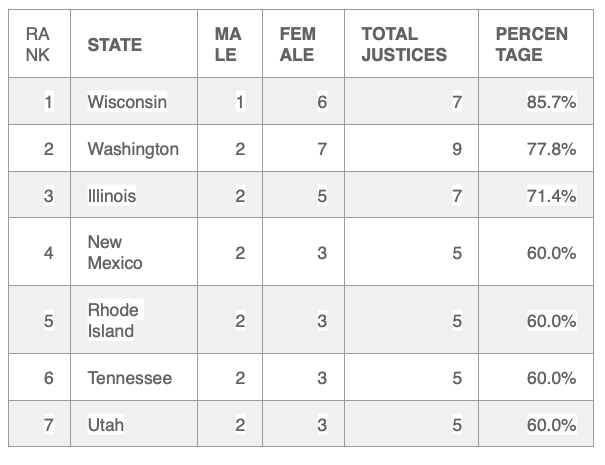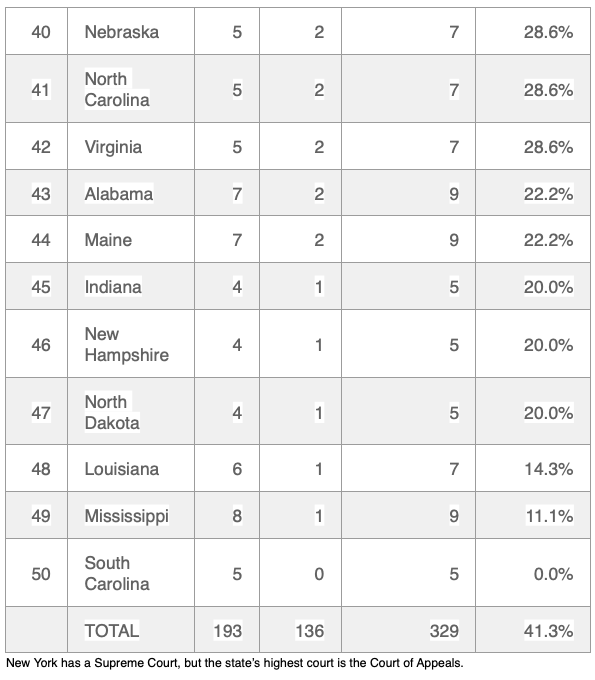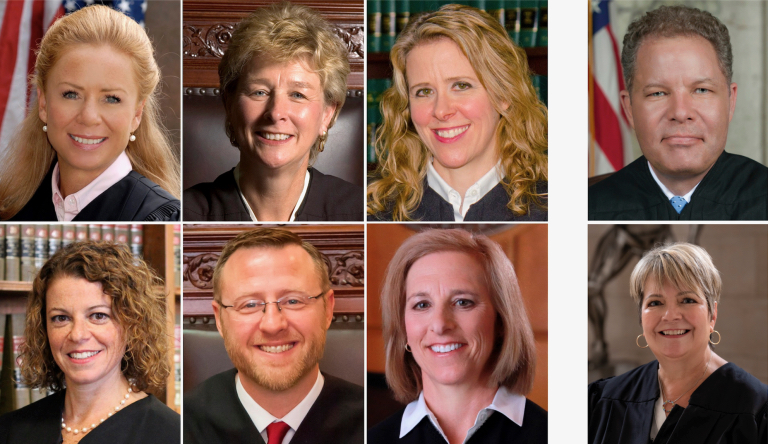Editor’s note: The following story has been shared for publication by The Badger Project, which, according to its website, is a nonpartisan, citizen-supported journalism nonprofit in Wisconsin. A link to the publication is here: https://thebadgerproject.org.
By Peter Cameron/The Badger Project
This year’s campaign for the Wisconsin Supreme Court is again so hard-fought and expensive, the historic gender makeup of the court has been almost an afterthought.
With six of seven female justices, the Wisconsin Supreme Court has the highest proportion of women — 86% — of all the country’s top state courts, an analysis by The Badger Project has found.
Nationally, 136 of the approximate 330 sitting justices – about 41%– on the highest court in each state are women, according to The Badger Project review.
In 2020, the last time The Badger Project ran these numbers, 38% of all justices on the top state courts were female.
The other state supreme courts with the highest female-to-male ratio are in Washington and Illinois.
Seven of Washington’s nine high court judges, or about 78%, are women. Five of Illinois’ seven Supreme Court judges, or 71%, are female.
South Carolina’s five Supreme Court justices are men, making it the only all-male high state court in the U.S.
Close behind is the Mississippi Supreme Court, which has one female justice on its nine-judge panel. One of Louisiana’s seven justices, or approximately 14%, is a woman. Indiana, New Hampshire and North Dakota each have one female justice on their five-member courts for compositions that amount to 20% female.
The U.S. Supreme Court’s four women justices give it a female composition of about 44%.
Landmark decisions on the horizon
The Wisconsin Supreme Court has had six women and one man since 2020, when former justice and current candidate Daniel Kelly lost his reelection attempt to Justice Jill Karofsky. The court very nearly could have been all female, but Justice Brian Hagedorn defeated State Appeals Court Judge Lisa Neubauer in 2019 by a sliver — about 6,000 votes, or half a percentage point.
Kelly, the right-leaning candidate, is running to reclaim a seat on the court against the left-leaning candidate and Milwaukee County Judge Janet Protasiewicz in the April election. If he wins, the court would return to five women and two men, dropping the state high court’s gender makeup to a 71% female composition that would give it the second-highest rate in the U.S.
The Wisconsin Supreme Court’s six female justices are generally seen as being divided 3-3 on the ideological spectrum. Hagedorn, a right-leaning justice and the court’s lone male, often serves as the swing vote, which often, but not always, yields conservative rulings.
No matter who wins the seat, the Wisconsin Supreme Court will likely decide monumental issues soon, including the legality of abortion in the state, and the state’s gerrymandered political districts. The election is simple in that a victory for the left-leaning candidate will flip the court to one controlled by its liberal wing. A win by the right-leaning candidate means that faction will continue its majority.
A 2010 study on female federal court judges shows that their presence rarely affects the outcomes of cases.
“Rarely, though,” the study reports, “is not never.”
The study, “Untangling the Causal Effects of Sex on Judging” by Christina L. Boyd and others, found an exception when courts rule on gender discrimination disputes.
The presence of female judges often caused male judges “to vote in a way they otherwise would not – in favor of plaintiffs,” the study reported.
The findings were similar to conclusions from some other research on the effect of gender in court judgments in cases dealing with employment issues, the Boyd study said. The Boyd study also suggested that as the backgrounds and experiences of judges widens, so does the range of ideas and information brought to the judicial process.
These results may provide evidence for claims arguing for diversity on the bench, the study claims.
Though the Wisconsin Supreme Court may be a ground-breaker in gender makeup, it is not racially diverse. All the justices are white. The last non-white judge to sit on the court was Justice Louis Butler, appointed to the state’s highest court by former Gov. Jim Doyle, a Democrat, in 2004.
Butler lost his reelection campaign in 2008 to Justice Michael Gableman, a white man.
A gender breakdown of justices on top state courts across the U.S. follows.





Clockwise from top left: Chief Justice Annette Ziegler, Justice Ann Walsh Bradley, Justice Rebecca Grassl Bradley, former Justice Daniel Kelly, Milwaukee County Judge Janet Protasiewicz, Justice Jill Karofsky, Justice Brian Hagedorn, and Justice Rebecca Dallet. Kelly and Protasiewicz are running for the open seat on the court.
Photos and graphics courtesy of The Badger Project.
This post has already been read 888 times!